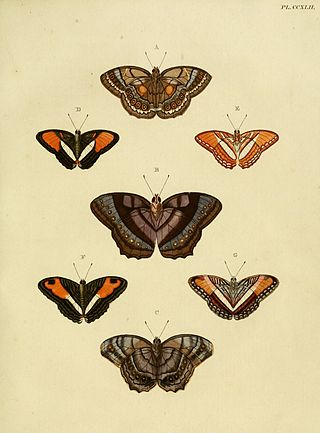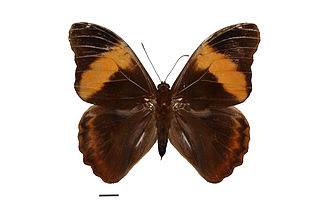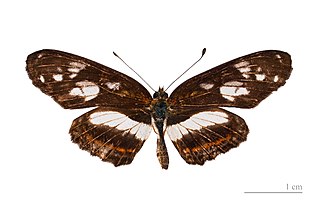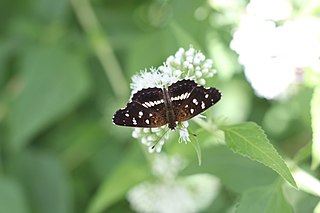
Danainae is a subfamily of the family Nymphalidae, the brush-footed butterflies. It includes the Daniadae, or milkweed butterflies, who lay their eggs on various milkweeds on which their larvae (caterpillars) feed, as well as the clearwing butterflies (Ithomiini), and the tellervini.

The morpho butterflies comprise many species of Neotropical butterfly under the genus Morpho. This genus includes more than 29 accepted species and 147 accepted subspecies, found mostly in South America, Mexico, and Central America. Morpho wingspans range from 7.5 cm (3.0 in) for M. rhodopteron to 20 cm (7.9 in) for M. hecuba, the imposing sunset morpho. The name morpho, meaning "changed" or "modified", is also an epithet. Blue morphos are severely threatened by the deforestation of tropical forests and habitat fragmentation. Humans provide a direct threat to this spectacular creature because their beauty attracts artists and collectors from all over the globe who wish to capture and display them. Aside from humans, birds like the jacamar and flycatcher are the adult butterfly’s natural predators.

Pieter Cramer was a wealthy Dutch merchant in linen and Spanish wool, remembered as an entomologist. Cramer was the director of the Zealand Society, a scientific society located in Flushing, and a member of Concordia et Libertate, based in Amsterdam. This literary and patriotic society, where Cramer gave lectures on minerals, commissioned and/or financed the publishing of his book De uitlandsche Kapellen, on foreign (exotic) butterflies, occurring in three parts of the world Asia, Africa and America.

Tirumala limniace, the blue tiger, is a butterfly found in South Asia, and Southeast Asia that belongs to the brush-footed butterfly family, Nymphalidae. More specifically it is part of the crows and tigers or danaid group. This butterfly shows gregarious migratory behaviour in southern India. In some places, it may be found in congregations with Danaus genutia, Tirumala septentrionis, Euploea sylvester, Euploea core, Parantica aglea, and at high elevations, with Parantica nilgiriensis, on Crotalaria.

Polygonia is a genus of butterflies with a conspicuous white mark on the underside of each hindwing, hence the common name comma. They also have conspicuous angular notches on the outer edges of their forewings, hence the other common name anglewing butterflies. The related genus Nymphalis also includes some anglewing species; Polygonia is sometimes classified as a subgenus of Nymphalis.

Prepona is a genus of Neotropical charaxine butterflies in the family Nymphalidae. They are strong fliers in tropical forests where they feed on fermenting fruits and animal dung. The underside of the wings is pale greyish or brownish, while the upperside is dark with distinct iridescent blue markings. A few species also have orange markings on the upperside of the wings. They are popular among butterfly collectors.

Junonia evarete, the tropical buckeye or South American tropical buckeye, is a South American butterfly of the nymphalid (Nymphalidae) family. It has characteristic eye spots on the wings, which have a wingspan between 4.5 and 6.5 cm. This butterfly is easily confused with Junonia genoveva, the mangrove buckeye. Not only have the common names mangrove and tropical buckeye been confused, but the butterflies themselves have been sometimes misidentified in past literature because the two species have many variations, subspecies and seasonal forms, which makes them difficult to identify or differentiate. Phylogenetic studies demonstrate the separation of evarete and genoveva, but evidence suggests that subspecies and perhaps more species await their descriptions within this group.

Phyciodes, the crescents or crescent spots is a genus of butterflies of the subfamily Nymphalinae in the family Nymphalidae.

Charaxes xiphares, the forest king emperor or forest king charaxes, is a butterfly of the family Nymphalidae. It is native to Afromontane forest in the eastern and southern Afrotropical realm.

Ortilia is a genus of butterflies of the family Nymphalidae found in South America.

Taygetis is a genus of satyrid butterflies found in the Neotropical realm.

Dynamine postverta, the Mylitta greenwing or four-spot sailor, is a butterfly in the family Nymphalidae. It is found throughout most tropical and subtropical areas of Central and South America, from Mexico south to Argentina and Paraguay. The habitat includes primary rainforests, humid deciduous woodlands, scrubby grassland and farmland at altitudes up to about 900 metres.

Adelpha cocala, the cocala sister or orange-washed sister, is a butterfly of the family Nymphalidae. It was described by Pieter Cramer in 1779. It is found from Honduras to Panama, Guatemala, Venezuela, Colombia, Suriname, Peru, Bolivia and Brazil.

Selenophanes cassiope, the cassiope owlet, is a butterfly of the family Nymphalidae. It was described by Pieter Cramer in 1775. It is found from Colombia through the Guianas to south-eastern Brazil.

Eresia clio, the common crescent or Clio crescent, is a butterfly of the family Nymphalidae. It was described by Carl Linnaeus in 1758. It is found from southern Mexico to Peru, Bolivia, the Guyanas and Brazil. The habitat consists of forest edges with low vegetation.

Eresia nauplius, the Peruvian crescent or Nauplius crescent, is a butterfly of the family Nymphalidae. It was described by William Chapman Hewitson in 1852. It is found in most of the Amazon region. The habitat consists of forest edges with low vegetation, including river banks, forest clearings, glades and roadsides.

Lycorea ilione, the clearwing mimic queen is a species of nymphalid butterfly in the subfamily Danainae. The species was first described by Pieter Cramer in 1775.

Ortilia ithra, or the Ithra crescent, is a species of butterfly in the family Nymphalidae. It is native to broadleaf forests in South America from Brazil to Argentina.


















